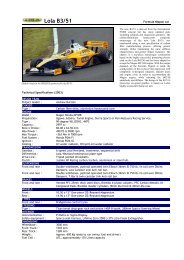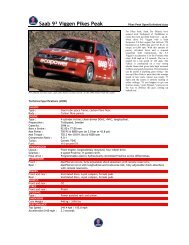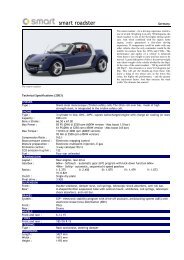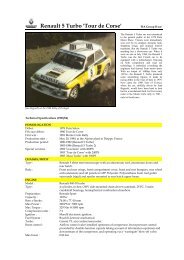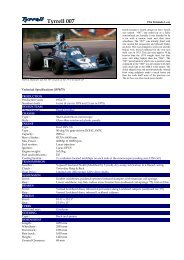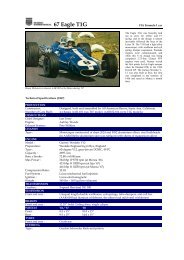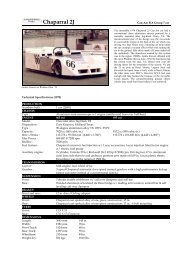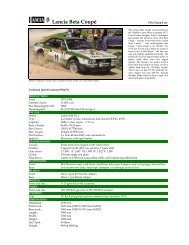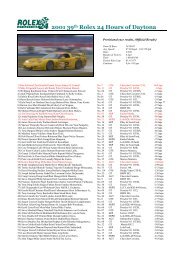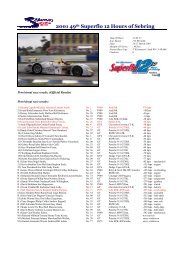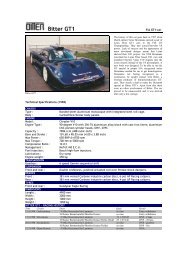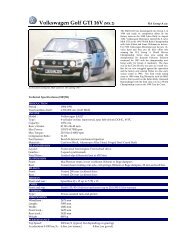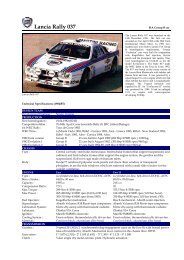02 Chevrolet Monte Carlo - Motorsports Almanac
02 Chevrolet Monte Carlo - Motorsports Almanac
02 Chevrolet Monte Carlo - Motorsports Almanac
You also want an ePaper? Increase the reach of your titles
YUMPU automatically turns print PDFs into web optimized ePapers that Google loves.
<strong>Chevrolet</strong> <strong>Monte</strong> <strong>Carlo</strong> NASCAR-car<br />
The #31 <strong>Chevrolet</strong> <strong>Monte</strong> <strong>Carlo</strong> driven by Robby Gordon..<br />
Technical Specifications (2003)<br />
GM Racing’s task was to design a car that<br />
not only conformed to the aerodynamic<br />
standards set by NASCAR but also retained<br />
the styling characteristics of the production<br />
<strong>Monte</strong> <strong>Carlo</strong>. The new design reflects<br />
<strong>Monte</strong> <strong>Carlo</strong>’s sporty style with familiar<br />
features, including a sloping hood, unique<br />
front and rear fascias, rear quarter glass<br />
panels, a short rear deck and a sleek overall<br />
shape. "The nose, front fascia and rear deck<br />
lid are definitely <strong>Monte</strong> <strong>Carlo</strong>," said Terry<br />
Laise, GM Racing’s chassis and aero<br />
development manager. "The most important<br />
part of the development program was to<br />
meet NASCAR’s aero criteria while<br />
retaining the lines and style of the <strong>Monte</strong><br />
<strong>Carlo</strong>. We are very pleased with the<br />
results."<br />
CHASSIS<br />
Type : Frame rectangular tube, Braces and Cage round tube (by Hendrick <strong>Motorsports</strong>)<br />
ENGINE<br />
Model : <strong>Chevrolet</strong> SB2.2<br />
Preparation : Hendricks <strong>Motorsports</strong> (various options)<br />
Type : 90-degree V8, OHV, 2VPC<br />
Capacity : 358 cu. in. (5853 cc)<br />
Bore x Stroke : 4.03 x 3.50” (1<strong>02</strong>.36 x 88.90 mm)<br />
Max Power : 775 bhp @ 8400 rpm<br />
Max Torque : 530 lbs.-ft.(719 Nm) @ 7000 rpm<br />
Compression Ratio : 12:1<br />
Induction : 830 cfm 4-Barrel Holley carburettor.<br />
Ignition System : MSD<br />
Lubrication System : Dry-sump, 16 US Quarts<br />
Fuel : 110 octane racing gasoline<br />
TRANSMISSION<br />
Gearbox : 4-speed Tex Racing T-101, H-pattern shift.<br />
Final Drive : Jericho limited slip differential (4.30 ratio)<br />
Clutch : Tilton<br />
SUSPENSION<br />
Front : Double A-arm, coil-springs, Penske (various options) dampers.<br />
Rear : Full-floating solid axle, trailing arms, coil-springs, Penske (various options)<br />
dampers, Panhard rod.<br />
BRAKES<br />
Front and rear : 12” vented Wilwood cast-iron discs, 6-piston Wilwood Integra 6 calipers.<br />
WHEELS<br />
Front and rear : 9.5 x 15” NASCAR Aero 95 steel.<br />
TYRES<br />
Front and rear : 28/12/15 Goodyear Racing Eagle D5704 radials.<br />
STEERING<br />
Type : Power-assisted heavy-duty worm and pinion.<br />
INTERIOR<br />
Seat : Butler with Willans 5 point harness.<br />
Gauges : Autometer<br />
DIMENSIONS<br />
Wheelbase : 110.0 in. 2794 mm<br />
Length : 197.9 in. 5<strong>02</strong>7 mm<br />
Width : 74 in. 1980 mm<br />
Height : 51 in. 1295 mm<br />
Front track : 60.5 in. (60.25 in. at Superspdw.) 1537 mm / 1530 mm<br />
Rear track : 60.5 in. (60.25 in. at Superspdw.) 1537 mm / 1530 mm<br />
Curb Weight : 3400 lbs. 1542 kg<br />
Ground Clearance : 4.0 in. 1<strong>02</strong> mm<br />
Weight Distribution : 52% front, 48% rear -<br />
Fuel Cell : 22 USG 83.3 litres
THE 2003 CHEVROLET MONTE CARLO<br />
New Aerodynamic Design With the Heart and Soul of a Champion<br />
As the most successful manufacturer in NASCAR history, <strong>Chevrolet</strong> is committed to continuing its winning<br />
record in the 2003 Winston Cup Series. Led by defending Winston Cup champion Tony Stewart, a strong team<br />
of <strong>Chevrolet</strong> drivers will depend on the new 2003 <strong>Monte</strong> <strong>Carlo</strong> race car to put them in the NASCAR winner’s<br />
circle. "Few vehicles have enjoyed the ongoing triumphs of <strong>Chevrolet</strong> <strong>Monte</strong> <strong>Carlo</strong>," said <strong>Chevrolet</strong> General<br />
Manager Kurt Ritter. "No manufacturer has carried more drivers to more Winston Cup championships than<br />
<strong>Chevrolet</strong>, and <strong>Monte</strong> <strong>Carlo</strong> has won more NASCAR races than any car in history. The newly designed <strong>Monte</strong><br />
<strong>Carlo</strong>, coupled with an impressive group of owners, drivers, and teams, promises to continue Chevy’s<br />
winning record in 2003 and beyond." An all-new <strong>Monte</strong> <strong>Carlo</strong> race car rolls onto the track and into the<br />
NASCAR record book in 2003. GM Racing engineers worked diligently with NASCAR officials and Winston Cup<br />
drivers, team owners, and engineers to develop the new <strong>Monte</strong> <strong>Carlo</strong>. Hendrick <strong>Motorsports</strong>, Dale Earnhardt<br />
Inc., Richard Childress Racing and Joe Gibbs Racing pooled their talents and played significant roles in the<br />
design of the new racer. "<strong>Chevrolet</strong> and GM Racing faced many challenges in 20<strong>02</strong>," said Doug Duchardt, GM<br />
Racing group manager. "Among those were the ongoing rules changes mandated by NASCAR in its attempt to<br />
level the playing field. We were at a definite disadvantage and wanted to establish aero parity. When we<br />
decided to build a new <strong>Monte</strong> <strong>Carlo</strong>, Joe Gibbs Racing was a big help to us. We learned from their<br />
experiences in building the new 2003 Pontiac Grand Prix, and applied that knowledge to create a new and<br />
distinctive <strong>Chevrolet</strong> <strong>Monte</strong> <strong>Carlo</strong> for Winston Cup competition." GM Racing’s task was to design a car that<br />
not only conformed to the aerodynamic standards set by NASCAR but also retained the styling characteristics<br />
of the production <strong>Monte</strong> <strong>Carlo</strong>. The new design reflects <strong>Monte</strong> <strong>Carlo</strong>’s sporty style with familiar features,<br />
including a sloping hood, unique front and rear fascias, rear quarter glass panels, a short rear deck and a<br />
sleek overall shape. "The nose, front fascia and rear deck lid are definitely <strong>Monte</strong> <strong>Carlo</strong>," said Terry Laise,<br />
GM Racing’s chassis and aero development manager. "The most important part of the development program<br />
was to meet NASCAR’s aero criteria while retaining the lines and style of the <strong>Monte</strong> <strong>Carlo</strong>. We are very<br />
pleased with the results." Chevy teams will continue to communicate with each other and with GM Racing<br />
engineers as they hone the performance of the new <strong>Monte</strong> <strong>Carlo</strong>. This cooperative effort among many of the<br />
best teams in the sport is a key component in <strong>Chevrolet</strong>’s strategy for success in stock car competition. "GM<br />
Racing works with the teams as a facilitator to see how we can help," said Alba Colon, GM Racing program<br />
manager. "There is constant communication between the Chevy teams. During the building of the new <strong>Monte</strong><br />
<strong>Carlo</strong> race cars, we held joint test sessions and worked with the teams in the wind tunnel. This close<br />
relationship will definitely be a plus for us in 2003." The 2003 season also marks the first year for Joe Gibbs<br />
Racing to field a pair of <strong>Chevrolet</strong>s for reigning Winston Cup champ Tony Stewart and 2000 Winston Cup<br />
champion Bobby Labonte. Having won two titles for Pontiac in the past three years, the Joe Gibbs Racing<br />
operation is a powerful addition to Team <strong>Monte</strong> <strong>Carlo</strong>. Hendrick <strong>Motorsports</strong> continues as a leading force for<br />
Team <strong>Monte</strong> <strong>Carlo</strong> with four-time Winston Cup champion Jeff Gordon, two-time champion Terry Labonte,<br />
Joe Nemechek and Jimmie Johnson. Gordon, the Labonte brothers and Stewart have dominated Winston Cup<br />
competition with seven titles in the past eight years. Richard Childress Racing is fielding a tough trio on the<br />
race track in 2003 with former NASCAR Busch Series champs Kevin Harvick and Jeff Green, along with former<br />
Indy, CART, and off-road racer Robby Gordon. Dale Earnhardt Inc. is also expected to be on the move with<br />
their winning drivers Dale Earnhardt Jr., Michael Waltrip and Steve Park. Andy Petree Racing remains in the<br />
Chevy camp in 2003 to round out an impressive field of five teams and 13 drivers for Team <strong>Monte</strong> <strong>Carlo</strong>.<br />
TALE OF TWO CHEVYS by Ben Stewart<br />
Chevy's <strong>Monte</strong> <strong>Carlo</strong> wins NASCAR races on Sunday and is sold at dealerships on Monday. But what's the<br />
same besides the nameplate?<br />
Better brace yourself because we're going to dispel some major myths. First, professional wrestling is a<br />
show, not a sport. Second, Janet Jackson's looks are a product of modern science, not heredity. And third, a<br />
Winston Cup car has more in common with an NHRA funny car than anything in a new car dealership. Sorry,<br />
but it's true. Even in NASCAR's earliest years, stock cars were never really "stock." As dirt tracks gave way to<br />
paved speedways, the races got longer and tougher and the stock parts began to fail. In the '50s, racers<br />
pirated heavy-duty suspension and axle components from trucks and bolted them onto their cars. Now that<br />
NASCAR has more than a half-century of evolution under its hood, the race cars are very far from their<br />
showroom origins. Everyone knows that all Winston Cup cars have a 4-barrel V8 up front driving the rear<br />
wheels and that the showroom versions of current Winston Cup cars are V6 front-drivers. But still, we<br />
thought it would be interesting to see if Winston Cup cars and their production counterparts share any<br />
discernible DNA. To help us find out, we enlisted the aid of Hendrick <strong>Motorsports</strong>. The folks there graciously<br />
offered the #25 car - the UAW-Delphi <strong>Chevrolet</strong> <strong>Monte</strong> <strong>Carlo</strong> - its entire team and driver Joe Nemechek. We<br />
were able to work with the team at Virginia International Raceway (VIR) as Nemechek and the team were<br />
dialing in the 25 car's road-course chassis at the track's 2.25-mile north course in preparation for tackling<br />
Sears Point. During breaks in the normal testing routine, Nemechek put his race car through our test regimen<br />
of acceleration, slalom, skidpad and braking that's normally reserved for more pedestrian transportation. He<br />
repeated the tests with a stone-stock <strong>Chevrolet</strong> <strong>Monte</strong> <strong>Carlo</strong> SS Dale Earnhardt Signature Edition. Oh yeah,<br />
we also had Nemechek lap both cars mercilessly around VIR to get his impressions of both. So here's what<br />
happened.<br />
Straight-Line Shocker<br />
You don't have to be an Einstein to figure out the 25 car's 780-plus horsepower should put a serious beating<br />
on a box-stock <strong>Monte</strong> <strong>Carlo</strong> in every speed contest. But what happened at the dragstrip was a surprise to<br />
everyone. Even with a freshly assembled Hendrick <strong>Motorsports</strong> 358-cu.-in. small-block Chevy engine, the
Winston Cup car didn't produce neck-snapping off-the-line acceleration. Nemechek's best 0-to-60 time in his<br />
car was a lackluster 6.21 seconds, only 2 seconds better than in our 200-hp, fresh-off-the-showroom-floor V6<br />
<strong>Monte</strong>. Why? Because on road courses, NASCAR teams use different gears in the transmission and rear end.<br />
And to make all four transmission gears usable at those tracks, they use a First gear in the 1.50:1 range, way<br />
too tall for a drag race. "I had to slip the clutch all the way out of the hole," says Nemechek. In fact, at over<br />
60 mph he was still slipping the clutch. After that, however, the acceleration curve was steeper than the<br />
Matterhorn. From 40 to 70 mph, the race car accelerated quicker than a Dodge Viper GTS and nearly three<br />
times as fast as the stock <strong>Monte</strong> <strong>Carlo</strong>. When he finished the quarter-mile, Nemechek was doing over 130<br />
mph. It was incredible to watch. The <strong>Monte</strong> <strong>Carlo</strong> SS didn't stand a chance--it crossed the same mark at just<br />
over 85 mph. If we had been testing an oval-track car with a deeper First gear, the race car would have<br />
been even quicker. A Winston Cup car has 12-in. race rotors and 6-piston calipers, so we expect it to have<br />
incredible brakes. And the 25 car does. But these brakes work best when they're warm. During our testing,<br />
they were cooler than a Klondike bar. Even so, Nemechek halted the race car from 60 mph, with little<br />
smoke or drama, in only 99 ft. That's 10 ft. less than the last Z06 Corvette we tested, and it's comparable to<br />
the CART and IRL cars we tested in 1998.<br />
Maximum G-Force<br />
The differences between Winston Cup cars designed for the speedways and those designed for a road course<br />
are most apparent in the suspensions. For both tracks, all teams use an independent double-wishbone<br />
suspension in the front and a Ford 9-in. live axle in the rear with trailing arms and a Panhard rod, coil<br />
springs and shocks. But the springs, shocks and Panhard rod location are totally different between the two<br />
race car setups. In fact, the springs and shocks are rated and valved differently at each corner of the car.<br />
And because 80 percent of Sears Point consists of right turns, camber settings are flip-flopped compared to<br />
an oval car. Also, those turns generate less g-force than at Talladega or Daytona, so the suspension is much<br />
softer too. As are the tire compounds. A Sears Point tire compound would make an oval car much faster, but<br />
the tires would be ready to blow out in less than three laps. Any way you slice it, a Winston Cup car chassis<br />
is worlds apart from the unibody, MacPherson-strut setup on a stock <strong>Monte</strong> <strong>Carlo</strong> SS. So with fresh 27.5x12-<br />
15 Goodyear road-course racing slicks, the UAW-Delphi <strong>Monte</strong> <strong>Carlo</strong> tore into our 200-ft. skidpad with<br />
Formula One ferocity. And its peak of 1.12 g's in both directions is better than any production car we've<br />
tested and close to Alex Zanardi's CART car we tested in 1998. The stock <strong>Monte</strong> SS squealed around the<br />
circle generating .80 g's. Not the stickiest sport coupe but not the sloppiest either. Due to a combination of<br />
time and testing conditions, our slalom results weren't representative of the true performance potential of a<br />
Winston Cup car. Nemechek drove both cars hard through our standard slalom, but some cooling problems<br />
forced our session to come to a close prematurely. In our abbreviated test, the Winston Cup car was about<br />
20 percent faster through the gates.<br />
Track Time<br />
When Nemechek lapped both cars around VIR's north course, we got more impressive and indicative<br />
comparison test results. Naturally, the Winston Cup car was at home here--it was created from the ground<br />
up for this specific task. And it was fast, pushing almost 150 mph on the short straights. It ran the 2.25-mile<br />
track in about 1 minute, 30 seconds. That was about 30 seconds faster than the showroom <strong>Monte</strong> <strong>Carlo</strong>.<br />
Interestingly, it was Nemechek's first experience on a road course in a street car. "I was amazed. I could<br />
actually make that car go anywhere I wanted. This thing really turned," he says. Impressive comments<br />
considering the production-line <strong>Monte</strong> makes do with modest street tires. Still, in Virginia's Miami-like<br />
summertime heat, we figured the stock <strong>Monte</strong> <strong>Carlo</strong>'s brakes would be cooked after just one lap. "There was<br />
a little brake fade, but not much," says Nemechek. "I could drive it down hard in the corners, stand on the<br />
brakes and let the ABS do the work for me. In my car, I have to worry about locking the rears." In a sport in<br />
which victory is decided in split seconds, half a minute every lap is an eternity. In a 60-lap race at this<br />
track, that's a half-hour. And in our test, those 30 seconds made the production car about 40 percent slower<br />
than the Hendrick <strong>Motorsports</strong> version.<br />
Finish Line<br />
In the end, the hard numbers showed the two cars to be light-years apart in both performance and<br />
technology. Nemechek's race car easily out-accelerated, outhandled and outstopped the production car.<br />
Still, on the ride home, we felt something deep inside the domesticated <strong>Monte</strong> <strong>Carlo</strong> we hadn't noticed<br />
before.<br />
SHOP TALK WITH GM RACING ENGINEER DOUG DUCHARDT<br />
GM racing engineer, Doug Duchardt, answers some of your questions about the current <strong>Monte</strong> <strong>Carlo</strong> on the<br />
street and on the track:<br />
Q. An all-new <strong>Monte</strong> <strong>Carlo</strong> race car debuted in 2000. What are three major differences between the<br />
current race car configuration and the 1999 model that it replaced?<br />
A. The 2000 <strong>Monte</strong> <strong>Carlo</strong> race car differs from the 1999 model in the following ways:<br />
• The roof is lower – creating more rear downforce.<br />
• The rear-window area is narrower – also creating more rear downforce.<br />
• And the nose is squarer – creating less downforce and drag.<br />
Q. NASCAR Winston Cup officials periodically take a race car from each manufacturer (<strong>Chevrolet</strong>,<br />
Pontiac, Dodge and Ford) to a wind tunnel in Marietta, Ga. What is the purpose of this test?<br />
A. The purpose of the NASCAR wind tunnel test is to compare aerodynamic characteristics (downforce and<br />
drag) to ensure equal performance from the different cars.<br />
Q. How does the size of the rear spoiler and the front air dam effect the <strong>Monte</strong> <strong>Carlo</strong> race car?
A. The size of the rear spoiler controls the rear downforce and drag. The larger the rear spoiler, the greater<br />
the downforce at the expense of increased drag. The position of the bottom edge of the front sir dam<br />
controls the front downforce.<br />
Q. Was the all-new <strong>Monte</strong> <strong>Carlo</strong> that debuted in 2000 first designed to be a race car or production car?<br />
A. The 2000 <strong>Monte</strong> <strong>Carlo</strong> was first designed to be a production car. Although GM Racing engineers worked<br />
with production engineers to ensure that product styling cues are in the race car as well.<br />
Q. How do the <strong>Chevrolet</strong> engineers assist the NASCAR Chevy teams during a race weekend and/or during<br />
a season?<br />
A. The <strong>Chevrolet</strong> engineers assist the teams as problem solvers. We address each team's specific difficulty at<br />
a race or throughout the season. Areas we work on include engine power, engine reliability, fuel economy,<br />
body downforce and drag, chassis setup and reliability, tire management and any other problems that are<br />
encountered.<br />
Q. Please explain the "stock" in a NASCAR stock car. What parts must conform to the measurements of<br />
the production <strong>Monte</strong> <strong>Carlo</strong>?<br />
A. The <strong>Monte</strong> <strong>Carlo</strong> race car uses a stock hood, windshield shape, roof, rear glass shape and decklid. Several<br />
of the templates very nearly fit the production <strong>Monte</strong> <strong>Carlo</strong>.<br />
Q. Why have the <strong>Monte</strong> <strong>Carlo</strong>s outperformed the other manufacturers on the "super speedways" in past<br />
races?<br />
A. The <strong>Monte</strong> <strong>Carlo</strong> success on the "super speedways" is a result of outstanding teams and drivers, an<br />
aggressive aerodynamic development program in optimizing the <strong>Monte</strong> <strong>Carlo</strong> to the NASCAR rules and a<br />
substantial wind tunnel and track study to help the drivers manage the draft.<br />
Q. What happens during the pre-race inspection?<br />
A. NASCAR uses up to 20 templates and 40 other dimensions to assure the cars fit the rules. They also check<br />
engine components, compression ratio and safety items.<br />
Q. What are some of the similarities between the SB2 racing engine and the 3800 engine in the<br />
production <strong>Monte</strong> <strong>Carlo</strong>?<br />
A. Some of the similarities between the SB2 and 3800 include basic two-valve push rod engine geometry,<br />
valvetrain technology and increased engine speeds for efficiency and power.<br />
Q. What technology transferred between the race car and the streetcar?<br />
A. Technology transfers include the following:<br />
• Aerodynamics, including drag reduction and managed lift balance<br />
• Combustion management<br />
• Engine airflow management<br />
• Materials applications<br />
• Chassis tuning<br />
• Brake cooling<br />
THE CHEVROLET SB2 ENGINE<br />
On March 26, 1955, the world of stock car racing changed forever. On that fateful day, Fonty Flock drove<br />
Frank Christian’s 1955 <strong>Chevrolet</strong> to victory in a 200-lap Grand National race on a dusty half-mile oval in<br />
Columbia, S.C. It was <strong>Chevrolet</strong>’s first NASCAR victory and the first major win for the legendary smallblock<br />
V8. It would not be the last. GM has produced more than 65 million small-block V8s – and a fair number of<br />
them ended up on race tracks. In fact, the classic Chevy is the most successful production engine in<br />
motorsports history. This lightweight, high-revving engine dominated stock car competition for decades,<br />
eclipsed only during periods when the rulebook favored behemoth big-block powerplants. GM engineers kept<br />
the small-block V8 forever young with a steady flow of new heavy-duty components. Improved blocks, freebreathing<br />
aluminum cylinder heads and forged-steel crankshafts maintained the little Chevy’s place on the<br />
cutting edge. But as the all-conquering small-block approached its 40th birthday in 1995, GM Racing<br />
engineers realized that the venerable motor was reaching its limits. Work began on the small-block’s<br />
successor, designated "SB2" – shorthand for "Small-Block – Second Generation." First presented to NASCAR<br />
officials in October 1995, the SB2 finally won approval for Winston Cup competition at the start of the 1998<br />
season. The SB2 was subsequently introduced to the Busch Grand National and Craftsman Truck series. The<br />
SB2 is a comprehensive engine package that was designed by GM Racing to improve durability, to simplify<br />
preparation procedures and to reduce the overall cost of building and maintaining a stock car racing engine.<br />
In short, the SB2 makes state-of-the-art technology affordable and accessible. "The SB2 marks the first time<br />
in the history of the GM small-block V8 that a package of engine components was specifically developed for<br />
NASCAR racing competition," said Jim Covey, NASCAR engine development manager for GM Racing. "GM had<br />
never designed a cylinder head specifically for a single four-barrel stock car engine," explained GM Racing<br />
Lead Engine Designer Roger Allen. "When the SB2 project began in earnest, we had an opportunity to make a<br />
significant improvement over existing engines." The new SB2 small-block V8 powers Team <strong>Monte</strong> <strong>Carlo</strong> in<br />
NASCAR Winston Cup and Busch Grand National competition, as well as Silverado pickups in the Craftsman<br />
Truck Series. The SB2 engine package was developed specifically for single fourbarrel NASCAR engines. The<br />
SB2’s valves and intake runners are positioned to provide a direct "line-of-sight" path from the carburetor to<br />
the combustion chambers. All eight intake ports are angled toward the center of the engine; the runners<br />
that supply the front cylinders are a mirror image of the ports that feed the rear cylinders. This innovative<br />
valve layout lead to corresponding revisions in the small-block’s camshaft, intake manifold, pistons,<br />
headers, and valvetrain. "The SB2 was a ‘clean-sheet-of-paper’ design, although we did honor the smallblock’s<br />
traditional architecture and head bolt pattern," explained Allen. "We applied airflow technology<br />
from road racing and Pro Stock drag racing engines to the single four-barrel stock car package. "One of the
keys to the SB2’s performance is the shape of the inlet runners," he continued. "The SB2 was designed to use<br />
shaft-mounted offset rocker arms which relocated the pushrods away from the ports. We did not have to<br />
compromise the port width to clear the pushrods, so we were able to achieve a more constant crosssectional<br />
area throughout the runner." NASCAR regulations mandate a maximum compression ratio of 12:1.<br />
Material was added to the SB2 casting to accommodate this rule. The SB2's two-piece intake manifold<br />
comprises a "spider" (plenum and runners) and a separate lifter valley cover that incorporates the water<br />
cross-over, water outlet, and distributor mount. This two-piece design simplifies at-track service because<br />
the manifold section can be removed without draining the coolant or removing the distributor. When GM<br />
Racing engineers set out to build a better small-block, they enlisted the aid of NASCAR teams who build<br />
literally hundreds of competition engines every season. This partnership between racers and engineers<br />
benefited both groups. "By working with GM teams from the very beginning of the project, we were able to<br />
meet their concerns about service and reliability issues that we may not have considered as designers," Allen<br />
noted. Although the SB2 is firmly rooted in the classic small-block architecture, it is a purposeful and<br />
thoughtful revision designed specifically for NASCAR stock car racing. Working within the boundaries<br />
established by the rulemakers, GM Racing has created a two-valve pushrod V8 for the 21st century.<br />
CHEVROLET DEBUTS SB2 SMALL-BLOCK V8 AT DAYTONA 15/<strong>02</strong>/1998<br />
WARREN, Mich. - <strong>Chevrolet</strong> NASCAR Winston Cup teams will debut the new SB2 ("Small-Block- Second<br />
Generation") racing engine in the season-opening event of the NASCAR Winston Cup series at Daytona<br />
International Speedway. The new SB2 engine marks the first time in the 43-year history of the <strong>Chevrolet</strong><br />
small-block V8 that a package of engine components has been developed specifically for Winston Cup<br />
competition. "The SB2 small-block V8 is the most comprehensive new competition engine package that has<br />
been designed, tested, developed, and marketed by General Motors," said Herb Fishel, director of GM<br />
<strong>Motorsports</strong>. "It is the most innovative approach to delivering advanced technology to engine builders and<br />
racing teams in the long history of the small-block V8." Like the production 3.8-litre 3800 Series II V6 that<br />
powers the 1998 <strong>Monte</strong> <strong>Carlo</strong> Z34, the SB2 racing engine is a highly refined two-valve pushrod powerplant.<br />
The <strong>Monte</strong> <strong>Carlo</strong>'s 200-horsepower V6 has been acclaimed as one of the 10 best engines for three consecutive<br />
years by the authoritative Ward's Auto World; the SB2 racing engine has been described as a revolutionary<br />
development in Winston Cup stock car racing. The SB2's mission is to maintain the <strong>Monte</strong> <strong>Carlo</strong>'s standing as<br />
the winningest nameplate in NASCAR history. GM <strong>Motorsports</strong> engineers, working in conjunction with top<br />
Winston Cup engine builders and aftermarket parts suppliers, developed the SB2 package to improve<br />
durability, simplify preparation procedures, and reduce the cost of building and maintaining a small-block V8<br />
racing engine. The SB2's design is optimized for a single four-barrel induction system as required by NASCAR<br />
Winston Cup rules. Compared to the <strong>Chevrolet</strong> Bow Tie cylinder heads used previously by NASCAR teams, the<br />
SB2's intake and exhaust valves are repositioned and relocated to provide a direct "line of sight" path from<br />
the carburetor to the combustion chambers. The SB2's intake ports are angled toward the carburetor, giving<br />
the head an innovative "mirror port" design that is radically different from both conventional small-block<br />
<strong>Chevrolet</strong> heads and Ford racing heads. The SB2 small-block was designed to make life simpler and less<br />
expensive for NASCAR teams. Airflow and power output are equivalent to the highly-modified Bow Tie heads<br />
used previously-but preparation time is dramatically shortened, and valvetrain and piston reliability is<br />
significantly improved. Major components of the SB2 small-block V8 are available from GM Performance<br />
Parts, including a heavy-duty engine block, aluminum cylinder heads, intake manifold, valley cover, and<br />
rocker covers. Related components such as pistons, cams, rocker arms, and gaskets are produced by<br />
aftermarket manufacturers.<br />
SB2 Background<br />
American auto manufacturers introduced a new generation of overhead valve V8 engines in the late 1940's<br />
when NASCAR was in its infancy. Engines such as Oldsmobile's Rocket V8, which debuted in 1949, offered<br />
performance that was vastly superior to the flathead engines that powered most mass-produced vehicles.<br />
The overhead valve engines quickly established their dominance in stock car racing. In 1955, <strong>Chevrolet</strong><br />
introduced an all-new small-block V8 that changed the automotive landscape forever. Chevy's amazing<br />
small-block was lighter, simpler, easier to manufacture, and less expensive than other overhead valve<br />
engines. With its high-revving valvetrain and efficient port design, the small-block was also more powerful<br />
and responsive than its competition. Everyday drivers and racers both recognized the advantages of the<br />
small-block V8: General Motors has produced more than 65 million small-block engines since 1955, and the<br />
little Chevy V8 has become the most successful engine in motorsports. The original small-block <strong>Chevrolet</strong> V8<br />
produced 162 horsepower in 1955; today Winston Cup engine builders extract 700 horsepower from the same<br />
basic engine design. Winston Cup teams have paid a price for this dramatic increase in performance,<br />
however. The limitations of the original design were most apparent in the reduced reliability of the cylinder<br />
head and pistons. <strong>Chevrolet</strong>'s Bow Tie cylinder heads, which were originally designed in 1989 for drag racing,<br />
required extensive and expensive modifications to withstand the stress of oval track racing. Since 1992, Bow<br />
Tie heads have been the only heads approved by NASCAR for GM entries in Winston Cup competition. In<br />
1995, GM <strong>Motorsports</strong> engineers submitted the SB2 for approval by NASCAR officials. Their request was<br />
turned down, and <strong>Chevrolet</strong> teams continued to race with conventional Bow Tie heads. Development of the<br />
SB2 continued, however, and a revised version was designated "SB2.2." In August, 1997, NASCAR announced<br />
that the SB2.2 would be eligible for Winston Cup competition in 1998.<br />
SB2 Design Features<br />
Intake Ports - The SB2's intake ports are aimed toward the single four-barrel carburetor. These four equallength<br />
intake runners provide the straightest possible path from the carburetor to the intake valves. This<br />
design improves efficiency and promotes more uniform fuel distribution among the cylinders. GM engineers
changed the layout of the intake and exhaust valves in the SB2 head to accommodate the new port design.<br />
The SB2's intake valves are tilted ("splayed") four degrees toward the center of the cylinder. This compound<br />
intake valve angle (an innovation introduced on Chevy's "Mystery Motor" at the 1963 Daytona 500) improves<br />
breathing by moving the valve away from the cylinder wall at high lift. Pistons - The SB2 has a more durable<br />
piston design than its predecessor. SB2 pistons do not require the deep valve notches that are necessary<br />
with conventional Bow Tie cylinder heads. As a result, the pistons are less susceptible to cracking. Intake<br />
Manifold - The SB2 intake manifold is a two-piece casting with a lifter valley and a separate "spider"<br />
(carburetor pad and runners). The spider can be quickly removed and replaced without draining the engine<br />
coolant or removing the distributor, permitting race teams to change manifolds quickly.<br />
SB2 Summary<br />
The goals of the SB2 project were to design a more durable, more affordable and more efficient small-block<br />
V8 racing engine. As the 1998 Winston Cup season unfolds, the second-generation small-block will take its<br />
place as the successor to the winningest engine in auto racing. <strong>Chevrolet</strong> Media Online: http://media.gm.com/chevy<br />
NASCAR AERODYNAMICS<br />
The winds of change blow at hurricane force in the GM Aerodynamics Laboratory. Driven by a 4,000horsepower<br />
electric motor and pushed by a 43-foot propeller, the wind is on call 24 hours a day to provide<br />
data on aerodynamic forces. In the ultra-competitive world of Winston Cup racing, the curve of a fender or<br />
the shape of a windshield pillar can make the winning difference in a 500-mile marathon. Through constant<br />
testing and development, racing teams refine their cars’ aerodynamic packages to suit both the tracks and<br />
the drivers’ preferences. Low aerodynamic drag is a prerequisite for fast laps on NASCAR’s immense<br />
superspeedways. On short and intermediate circuits the emphasis shifts toward downforce to enhance<br />
handling. The NASCAR rulebook strictly limits the options, however. Critical dimensions such as overall<br />
length, width, height, wheelbase, and spoiler size are tightly regulated. "Advances in aerodynamics are<br />
predicated on testing and experience," said GM Racing engineer Terry Laise, the group’s aerodynamics<br />
specialist. "It is an advantage to have our own dedicated aerodynamics laboratory here at General Motors."<br />
The <strong>Monte</strong> <strong>Carlo</strong> shows its aggressive side with speedway-inspired styling. The contours of the street and<br />
racing versions were sculpted in the GM Aero Lab with an emphasis on aerodynamic efficiency. The racing<br />
version shares its hood, roof, and decklid sheetmetal with the production vehicle. "GM Racing engineers<br />
were involved in the very early stages of <strong>Monte</strong> <strong>Carlo</strong>’s development," said <strong>Monte</strong> <strong>Carlo</strong> Brand Manager Don<br />
Parkinson. "Their input helped <strong>Monte</strong> <strong>Carlo</strong> achieve a look that is attractive and functional. It’s a shape that<br />
works well on the street and on the racetrack." The science of aerodynamics has its own specialized<br />
vocabulary. "In the Aerodynamics Laboratory, we examine the way an automobile cuts through the wind in<br />
terms of its drag, lift, and yaw stability," Laise explained. "Drag is the resistance of a body moving through<br />
the air. The resistance you feel when you put your hand outside of a moving car is drag. The term<br />
‘coefficient of drag,’ or Cd, is a reflection of the aerodynamic efficiency of a body’s shape. Using the same<br />
example, when you turn your palm toward the wind, the coefficient of drag is high; when you turn your hand<br />
sideways, the drag is reduced. "A related concept is drag force, which takes into account the car’s frontal<br />
area and several constants. A jumbo jet, for example, has a lower Cd than a race car, but its drag force is<br />
much greater because of its larger frontal area. Safety is a critical element in stock car aerodynamics. Roof<br />
flaps and rails on the roof, decklid, and rear window are designed to prevent a spinning car from becoming<br />
airborne. The shapes of production and racing vehicles are refined in the GM Aerodynamics Laboratory to<br />
improve their aerodynamic efficiency. "NASCAR teams are concerned about aerodynamic drag because it has<br />
such an impact on speed," Laise continued. "When a car is running at 200 mph, improving its drag coefficient<br />
by just seven counts – a .007 reduction in its Cd – adds one full mile-perhour to its speed. "With NASCAR’s<br />
stringent rules, the race cars are very closely matched," he noted. "Consequently, even minute gains in<br />
aerodynamics, power, or chassis can be decisive. That is why the top teams are constantly working on<br />
engines and aerodynamics." Off the superspeedways the attention turns to downforce, the use of negative<br />
lift to hold the vehicle more tightly to the track. "On almost every race course that requires a change in<br />
speed because of a turn, you can achieve a greater improvement in lap times by making the car corner<br />
faster than by any other approach," Laise observed. "Stability is also essential when cars are racing just<br />
inches apart at high speeds," he continued. "Pitch is a measure of the lift at the front and rear of the<br />
automobile. Yaw is a measure of stability, like an airplane turning from side to side. A van that wanders<br />
from side to side on a windy day is an example of what happens when the center of pressure is far from the<br />
yaw center of the chassis. Ideally we tune these variables so a race car goes down the track like an arrow."<br />
Safety is another critical element in stock car aerodynamics. Rails on the roof, decklid, and rear window are<br />
designed to prevent a spinning car from becoming airborne by disrupting the flow of air. Roof flaps are also<br />
intended to keep the tires on terra firma. Without these aerodynamic devices, a car sliding backward acts<br />
like an airplane wing. The rails and roof flaps interrupt the flow of air across the roof that creates lift. The<br />
knowledge gained by teams and GM Racing engineers in the wind tunnel is one of the keys to <strong>Chevrolet</strong>’s<br />
success in major league auto racing. At the GM Aerodynamics Laboratory, the answers are blowing in the<br />
wind.
2003 NASCAR WINSTON CUP SERIES TEAMS<br />
Car Owner Team Driver Manufacturer<br />
#0 Gene Haas Haas CNC Racing Jack Sprague Pontiac<br />
#1 Teresa Earnhardt Dale Earnhardt Inc. Jeff Green <strong>Chevrolet</strong><br />
#01 Nelson Bowers MB2 <strong>Motorsports</strong> Jerry Nadeau Pontiac<br />
#01 Nelson Bowers MB2 <strong>Motorsports</strong> Mike Wallace Pontiac<br />
#01 Nelson Bowers MB2 <strong>Motorsports</strong> Jason Keller Pontiac<br />
#2 Roger Penske Penske Racing Rusty Wallace Dodge<br />
#4 Larry McClure Morgan-McClure <strong>Motorsports</strong> Mike Skinner Pontiac<br />
#5 Rick Hendrick Hendrick <strong>Motorsports</strong> Terry Labonte <strong>Chevrolet</strong><br />
#6 Jack Roush Roush Racing Mark Martin Ford<br />
#7 James Smith Ultra <strong>Motorsports</strong> Jimmy Spencer Dodge<br />
#07 James Smith Ultra <strong>Motorsports</strong> Ted Musgrave Dodge<br />
#8 Teresa Earnhardt Dale Earnhardt Inc. Dale Earnhardt Jr. <strong>Chevrolet</strong><br />
#9 Ray Evernham Evernham <strong>Motorsports</strong> Bill Elliott Dodge<br />
#10 James Rocco MBV <strong>Motorsports</strong> Johnny Benson Pontiac<br />
#11 Diane Bodine Brett Bodine Racing Geoffrey Bodine Ford<br />
#11 Diane Bodine Brett Bodine Racing Brett Bodine Ford<br />
#12 Roger Penske Penske Racing Ryan Newman Dodge<br />
#14 A J Foyt A.J. Foyt Racing Larry Foyt Dodge<br />
#15 Teresa Earnhardt Dale Earnhardt Inc. Michael Waltrip <strong>Chevrolet</strong><br />
#16 Geoffrey Smith Roush Racing Greg Biffle Ford<br />
#17 Mark Martin Roush Racing Matt Kenseth Ford<br />
#18 Joe Gibbs Joe Gibbs Racing Bobby Labonte <strong>Chevrolet</strong><br />
#19 Ray Evernham Evernham <strong>Motorsports</strong> Jeremy Mayfield Dodge<br />
#20 Joe Gibbs Joe Gibbs Racing Tony Stewart <strong>Chevrolet</strong><br />
#21 Glen Wood Wood Brothers Racing Ricky Rudd Ford<br />
#22 Bill Davis Bill Davis Racing Ward Burton Dodge<br />
#23 Gail Davis Bill Davis Racing Kenny Wallace Dodge<br />
#24 Rick Hendrick Hendrick <strong>Motorsports</strong> Jeff Gordon <strong>Chevrolet</strong><br />
#25 Joe Hendrick Hendrick <strong>Motorsports</strong> Joe Nemechek <strong>Chevrolet</strong><br />
#29 Richard Childress Richard Childress Racing Kevin Harvick <strong>Chevrolet</strong><br />
#30 Richard Childress Richard Childress Racing Steve Park <strong>Chevrolet</strong><br />
#31 Richard Childress Richard Childress Racing Robby Gordon <strong>Chevrolet</strong><br />
#32 Calvin Wells PPI <strong>Motorsports</strong> Ricky Craven Pontiac<br />
#33 Andy Petree Andy Petree Racing Christian Fittipaldi <strong>Chevrolet</strong><br />
#37 Derrike Cope Quest Motor Racing Derrike Cope <strong>Chevrolet</strong><br />
#38 Robert Yates Robert Yates Racing Elliott Sadler Ford<br />
#40 Chip Ganassi Chip Ganassi Racing Sterling Marlin Dodge<br />
#41 Chip Ganassi Chip Ganassi Racing Casey Mears Dodge<br />
#42 Chip Ganassi Chip Ganassi Racing Jamie McMurray Dodge<br />
#43 Richard L Petty Petty Enterprises John Andretti Dodge<br />
#45 Pattie Petty Petty Enterprises Kyle Petty Dodge<br />
#48 Jeff Gordon Hendrick <strong>Motorsports</strong> Jimmie Johnson <strong>Chevrolet</strong><br />
#49 Elizabeth Morgenthau BAM Racing Ken Schrader Dodge<br />
#57 Edward Campbell CLR Jeff Fultz Ford<br />
#60 Rick Hendrick Hendrick <strong>Motorsports</strong> David Green <strong>Chevrolet</strong><br />
#66 Travis Carter Travis Carter <strong>Motorsports</strong> Hideo Fukuyama Ford<br />
#74 Bill Baumgardner BACE <strong>Motorsports</strong> Tony Raines <strong>Chevrolet</strong><br />
#77 Douglas Bawel Jasper <strong>Motorsports</strong> Dave Blaney Ford<br />
#88 Robert Yates Robert Yates Racing Dale Jarrett Ford<br />
#90 W.C. "Junie" Donlavey Donlavey Racing Jason Hedlesky Ford<br />
#97 Georgetta Roush Roush Racing Kurt Busch Ford<br />
#99 Jack Roush Roush Racing Jeff Burton Ford<br />
#135 Ed Rensi Team Rensi <strong>Motorsports</strong> Bobby Hamilton Jr. Ford<br />
#154 Sam Belnavis/Travis Carter BelCar Racing Todd Bodine Ford<br />
#171 Donna Lepage Matrix <strong>Motorsports</strong> Kevin Lepage Ford<br />
#183 Armando Fitz FitzBradshaw Racing Kerry Earnhardt <strong>Chevrolet</strong><br />
#184 Norm Benning Benning Racing Norm Benning <strong>Chevrolet</strong><br />
#189 Cindy Shepherd Shepherd Racing Morgan Shepherd Ford<br />
#275 Mike Starr Team Texas David Starr <strong>Chevrolet</strong>
IMAGE GALLERY<br />
Steve Park at Las Vegas during ’03 Kevin Harvick showing the <strong>Monte</strong> <strong>Carlo</strong> rear at Dover’03.<br />
The cockpit of Joe Nemechek’s Hendrick <strong>Motorsports</strong> car. The venerable 5.9litre push-rod V8.<br />
Joe Nemechek at Daytona with his NASCAR <strong>Chevrolet</strong> <strong>Monte</strong> <strong>Carlo</strong>.<br />
SOURCES<br />
http://media.gm.com/chevy/98news/c98<strong>02</strong>15d.htm<br />
http://media.gm.com/gmracing/nascar/chevy_technology.pdf<br />
http://media.gm.com/gmracing/press_kits/chevy/chevymontecarlo.htm<br />
http://www.chevrolet.com/chevyracing/winston/<br />
http://www.jeffgordon.com/car/car.html<br />
http://www.nascar.com/drivers/list/wc/tps/owner_team_series_index.html<br />
http://www.geocities.com/MotorCity/1290/wccarspec.html<br />
http://popularmechanics.com/automotive/motor_sports/20<strong>02</strong>/11/two_chevys/print.phtml<br />
© Compilation by Rainer Nyberg 2003-06-23 Fact-sheet 03/081



